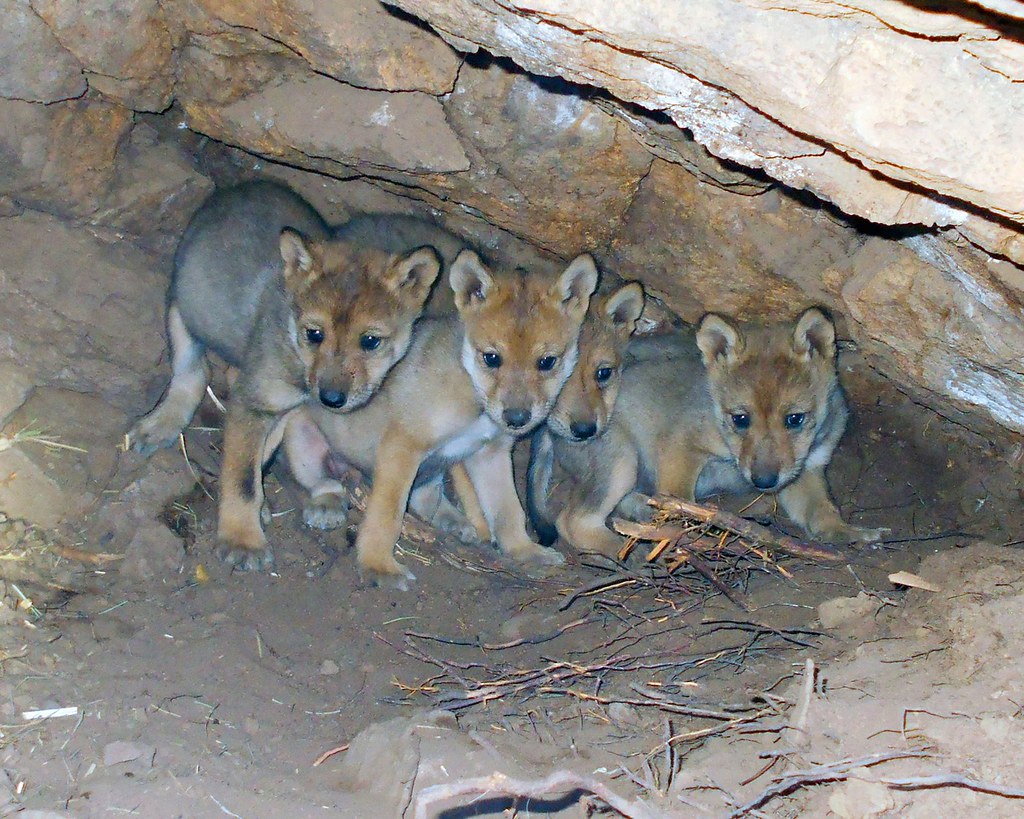The last member of a pack of endangered Mexican gray wolves in New Mexico’s Gila National Forest was eliminated in late April, due to trapping and killing by both private individuals and federal agents acting on behalf of the livestock industry.

The Prieto pack has roamed several miles southeast of the New Mexico-Arizona border since Mexican gray wolves were reintroduced to the region in 1998. In March, the US Fish and Wildlife Service (FWS) authorized the killing of the pack’s alpha male and a pup, and several other pack members were trapped, maimed, or killed by private parties and federal agents in 2018 and 2019. Then, on April 24 this year, the alpha female and last remaining adult was caught in a privately set trap. She died in federal custody a day later — apparently of “capture myopathy,” a stress response in which the body overheats — marking the definitive demise of the pack.
The Center for Biological Diversity (CBD) called these killings “the bloodiest bout of federal wolf-killing in the Southwest since 2006, when an entire nine-member wolf family in Arizona was taken out.”
“This latest incident is the cruel final blow to the Prieto pack, which struggled for two years to survive the Fish and Wildlife Service and avowed wolf-haters in the livestock industry,” Michael Robinson, a senior conservation advocate at CBD and author of Predatory Bureaucracy: The Extermination of Wolves & the Transformation of the West, said in a statement last month.
The incident highlights longstanding tensions between wildlife conservationists like Robinson, working to restore the endangered wolf species, and ranchers who oppose the wolves’ reintroduction to the wild.
The Mexican gray wolf (Canis lupus baileyi), which once roamed in abundance in the American Southwest and in northern and central Mexico, is the southernmost-occurring subspecies of gray wolf on the North American continent. It is also the most endangered. Earlier this year, the FWS reported only 163 wild Mexican wolves living in Arizona and New Mexico, and 30 living in Mexico.
In the mid-twentieth century, the Mexican gray wolf was driven close to extinction due to US government-sanctioned predator control programs. Livestock grazing on public lands had decreased elk and deer populations and, given the absence of native prey, caused Mexican wolves to prey on domesticated livestock. The predator control programs paid hunters to trap and kill wolves in order to appease the livestock industry, and by the 1940s, the federal government had successfully eliminated all breeding Mexican wolves in the US. In 1976, when the Mexican wolf was listed as an endangered species, it was nearly extinct in the wild.
In 1982, the US and Mexico adopted the Mexican Wolf Recovery Plan, initiating captive breeding programs in both countries. The FWS began capturing surviving wild Mexican wolves to be bred in captivity and eventually reestablished more than 100 wolves to a small portion of their historic range.

Opposition from ranchers and hunters led federal biologists to stall the release of wolves bred in captivity until the late 1990s, but environmentalists filed lawsuits against the FWS for its failure to comply with the Endangered Species Act. In 1998, a group of 11 Mexican wolves was eventually released into the “Blue Range Wolf Recovery Area,” a 6,850-square-mile area spanning parts of Arizona and New Mexico.
The lineage of all Mexican wolves now living in the wild can be traced back to a founding stock of seven wolves bred in captivity. The loss of genetic diversity among Mexican wolves due to inbreeding drastically increases the threat of extinction for the already precarious population.
Today, conservation groups continue to spar with private ranchers, who oppose reintroduction of the wolves on public lands also used for livestock grazing. Many wolf advocates criticize the FWS for being heavily influenced by — and often acting on behalf of — the livestock industry. The federal government continues to authorize the removal or extermination of so-called “problem wolves” that prey on livestock.
“I work for the American people,” Brady McGee, Mexican Wolf Recovery Coordinator at the FWS, told the Journal in response to the concern that some of the agency’s policies seem aimed at satisfying special interests. “The Fish and Wildlife Service is here to represent all walks of life, and that includes the livestock industry as well as environmental groups. What we are trying to do is conserve species for the benefit of all people, and so it is a balance.”
Conservationists, however, point to how the FWS efforts to appease the livestock industry compromise the agency’s ability to effectively carry out its mission to conserve species. “These endangered animals are being killed at the behest of the agency charged with recovering them,” Sandy Bahr, director of the Grand Canyon Chapter of the Sierra Club, said in a statement. “We must insist that the agency abide by its responsibilities under the Endangered Species Act and focus on the welfare of these animals, not a few narrow special interests.”
Loose regulations and federal mismanagement of livestock grazing on public land are also points of concern for conservationists. When left unattended, the carcasses of cattle that have died from overgrazing-related causes — such as eating poisonous grasses or starvation — attract scavenging wolves that might then prey on other, still-living livestock in the area. Wolves that exhibit such “problem behavior” are then often removed or eliminated.
Conservationists argue that wolf-related livestock kills could be prevented by stricter regulations on the livestock industry to reduce overgrazing and promote overall habitat health. “Ranchers are allowed to graze their private livestock on public lands with so little accountability,” said Kirk Robinson of Western Wildlife Conservancy. “The wolves are the scapegoats, and lamentably, it puts their recovery at risk.”
In 2015, the FWS adopted a revised regulation plan for its management of the Mexican gray wolf for the first time since 1998. But wolf advocates said the new rules imposed unlawful roadblocks that would obstruct recovery of the endangered species by constricting the wolves to a small geographic range, arbitrarily limiting the wolves’ population numbers, and loosening rules against killing wild wolves.
Michael Robinson of CBD described the FWS’s current management of the endangered Mexican gray wolf, as outlined by the 2015 revision, as “a wolf control program, masquerading as a recovery program.”
For example, he noted, the government distributes radio telemetry devices to ranchers in order to “facilitate their own proactive management activities and aid in the detection and prevention of livestock depredations.” But doing so means providing many of the same individuals who publicly support killing wolves with devices that receive radio signals emitted from wolves’ collars, therefore stripping the wolves of their ability to stay hidden from private hunters and trappers, he told the Journal.
McGee described the distribution of radio telemetry devices as being one of the more effective tools used by the FWS to prevent livestock depredations, and said, “There is no evidence whatsoever, and there have been no cases, that these folks have gone out and hunted down wolves to shoot them or harm them in any way.”
As CBD’s Robinson pointed out, however, radio-collared wolves are still disappearing and being killed. “The Fish and Wildlife service is giving the tools to private individuals to enable them to be more efficient illegal wolf-killers,” he said. “The Fish and Wildlife Service is killing wolves, and the Fish and Wildlife Service is giving tools to private individuals to illegally kill wolves. It’s disgusting.”
In April 2018, in response to a lawsuit filed by CBD and Defenders of Wildlife, a federal court in Arizona rejected the FWS’s 2015 revision, ruling that the new regulations violated the agency’s legal responsibility to recover Mexican gray wolves under the Endangered Species Act. The federal judge noted that government officials had disregarded the advice of expert scientists who warned that the new regulations would compromise the wolf’s recovery.
The court also ordered the FWS to publish a revised management plan by May 1, 2021. The agency is currently accepting public comments as it prepares a supplemental environmental impact statement on its 2015 revision. The public comment period will be open until June 15.
In the meantime, according to CBD’s Robinson, the 2015 regulations are currently still in effect, and the FWS continues to act on behalf of the interests of the livestock industry, thus doing “terrible damage” to wolves. At this point, nothing will bring back the lost wolves of the Prieto pack, but conservationists still see hope for the species.
“We have an opportunity to change course,” Robinson said.
To learn more and submit a comment on the new management plan by June 15, go here.
We don’t have a paywall because, as a nonprofit publication, our mission is to inform, educate and inspire action to protect our living world. Which is why we rely on readers like you for support. If you believe in the work we do, please consider making a tax-deductible year-end donation to our Green Journalism Fund.
Donate